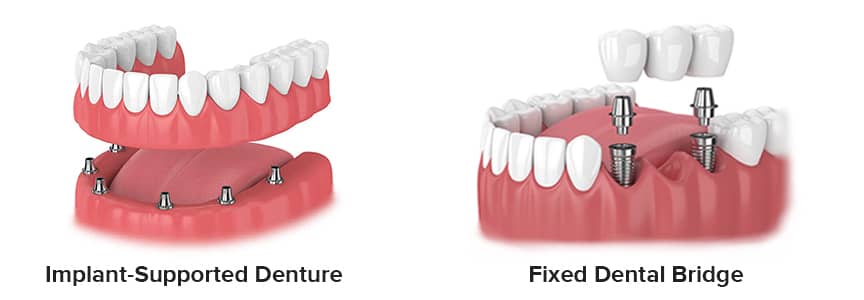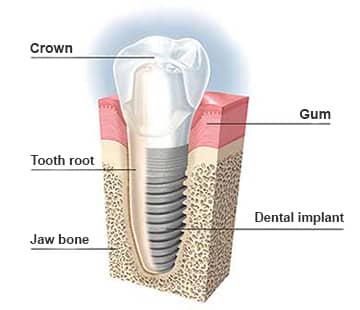An increasing number of people are becoming aware of dental implant treatment and how it could help them cope with tooth loss. Dental implants can offer a lifeline for people in Yonkers who have a loose and uncomfortable denture or teeth that are failing.
Dental implant treatment can help you to:
- restore smile
- eat and talk comfortably
Over the past few years, the selection of dental implant treatments available has increased considerably, and there are numerous options to consider. If you’re interested, you could find more than one solution is available to you.

One burning question that everybody wants to know is how many dental implants will they need?
It’s impossible for anyone to give a straight answer to this question unless they are an experienced dental implant dentist who has assessed your dental health and the quality of your jawbone.
The number of dental implants we use in our implants center in Yonkers can vary according to the treatment chosen and may range from as few as just two dental implants, while sometimes as many as eight dental implants are needed to get optimum results.
 Several factors can influence the number of dental implants needed, and which will help give you an idea as to why it’s impossible to provide a straight answer to this question.
Several factors can influence the number of dental implants needed, and which will help give you an idea as to why it’s impossible to provide a straight answer to this question.
Usually, the number required implants depends on:
- whether your upper or lower jaw is being treated
- the amount of healthy and strong bone available
Fixed or removable prosthesis?
It makes a difference as to whether you choose a fixed prosthesis such as a dental bridge, or opt for a removable prosthesis, for example, an implant-supported denture.
Another factor is the way you chew food and the way your facial muscles operate because when planning your implant treatment, your dentist must ensure your facial muscles are adequately supported and that you can eat comfortably.
Why Does It Make a Difference If You Want Your Upper or Lower Teeth Restored?
It might seem as if your upper and lower jaw are the same, but in fact, they are very different. The bone in your upper jaw is generally softer and is where your sinus cavities are located. Your sinus cavities are air-filled spaces just above your upper back teeth.
Usually, the bone near to your sinus cavities is thinner, and when you lose teeth, then the sinus cavities can expand.
These are factors that can make placing dental implants in your upper jaw more challenging but certainly not impossible. It’s also the reason why people needing their upper back teeth replaced with dental implants will often have what’s called a sinus lift or sinus augmentation.
A sinus lift is a bone grafting procedure which “lifts” the membrane in between your sinus cavities and your jawbone to create additional space for bone grafting material.
As your upper jawbone is softer, it’s almost always necessary to use a larger number of implants when restoring a complete set of teeth, regardless of whether your prosthesis will be fixed or removable. At a minimum, four dental implants are needed, but you might need as many as eight dental implants.
The Differences with Your Lower Jaw
The bone in your lower jaw is very different and is much denser and stronger, allowing your dental implant dentist to place fewer dental implants while still achieving a good stable result.
One problem with the lower jawbone is the presence of two large nerves which must be avoided during surgery.
These nerves are identified by your implant dentist when they take your cone beam CT scan, and your surgery will be planned to avoid placing the dental implants near to these nerves.
As these nerves are located towards the back of the mouth, it can make it more difficult to place implants to replace lower back teeth. It’s also the reason why when restoring a complete arch of teeth, dental implant dentists will usually place most of the implants towards the front of the mouth.
The bone is naturally denser and thicker in this area, so it can securely hold the dental implants without the need for bone grafting.
Sometimes it’s possible to restore a complete arch of lower teeth with as few as two dental implants, especially if you want a removable prosthesis such as an implant-retained denture that snaps onto the dental implants. Although this type of prosthesis may rock back and forth slightly when you chew, it’ll still be much more stable than an ordinary denture.
Four Dental Implants
Often, four dental implants are used to restore a complete lower arch of teeth, providing a very stable restoration. You may hear this treatment called All-on-Four, and it’s a tried and tested procedure.
Sometimes it’s even possible to fit the new teeth on the same day of surgery, so you may hear this procedure referred to as being “teeth in a day.”
With this treatment, four dental implants are placed towards the front of the lower jaw.
Two Dental Implants
The two dental implants right at the front of the mouth are placed vertically, but the two either side are angled backward.
There’s an excellent reason for this because these dental implants can then be longer than average, creating greater stability because of increased surface contact with your jawbone.
Once your new implant teeth are fitted onto the dental implants, they help to lock all four dental implants in place, ensuring your dental implants cannot move during the healing process.
All Dental Implants Must Fuse with Your Jawbone
The healing process is something that must occur with every type of implant treatment as once the dental implant posts are inserted they begin to bond or fuse with the surrounding bone. During the healing process your body creates new bone to surround the implant posts, and several months later, the implant posts should be securely fused in your jawbone.
Fixed or Removable?
Most people, given the opportunity, will opt for fixed teeth that look just like their natural teeth, making it easy to forget about their tooth loss.
However, it’s worth remembering that fixed prostheses can be tricky to clean.
Without proper cleaning, the tissues around the dental implants including the bone and gum can become infected, and the infection and inflammation may ultimately lead to implant failure.
Removable prostheses can be easier to keep clean and can still provide excellent results, so it’s worth considering all your options.
Do you have any questions about implants? Please contact our dentistry center located in Yonkers, Westchester County for a consultation with the periodontist Dr. Yana Rosenstein and the top dental implant specialists Dr. John Habib or Farzin Farokhzadeh, DDS.

